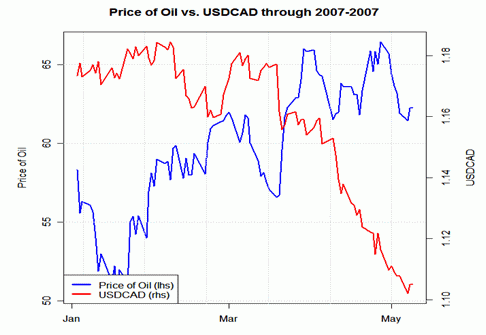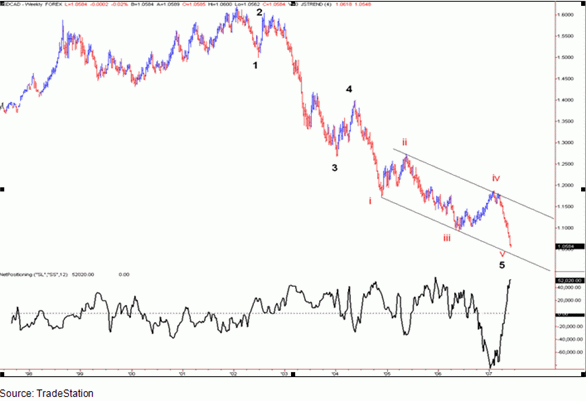| Canadian Dollar: How Much More Can It Rise? |
| By Kathy Lien |
Published
06/5/2007
|
Currency
|
Unrated
|
|
|
|
Canadian Dollar: How Much More Can It Rise?
The Canadian dollar has been on a tear. In the past three months, the currency has appreciated over 11 percent against the US dollar, putting parity within reach. At the beginning of the year, an exchange rate of 1.0 for USD/CAD seemed like a far fetched target, but now it has become a realistic one.
The Canadian dollar is trading not far from its 30 year highs (or conversely 30 year lows for USD/CAD), which means that the burning question in the minds of Canadian dollar traders is “How Low Can it Go?” Sentiment has become very one-sided and technicals indicate that the currency pair is extremely oversold. Yet fundamentally, the Canadian economy has been performing extremely well. At some point, the strength of the Canadian dollar will reverse the fundamental outlook and in order to figure out when that may happen, it is important to understand what is behind the latest move.
Is it Oil? No.
For once, the move is not driven by oil. The chart below illustrates the divergence in performance between oil prices and USD/CAD. Since March, which was the month when USD/CAD started to seriously breakdown, oil prices rallied, but have remained relatively range bound. Although it is trading not far from its year to date highs, it is still $13 off its all time high. The lowest level that USD/CAD reached when oil was at its record high was 1.0932. If this move was driven by oil, then oil prices would need to be very near if not above its prior high.

So If It Is Not Oil, What is Driving Canadian Dollar Strength?
The true catalysts behind the Canadian dollar’s strength are two primary factors; fundamental growth and acquisition flow.
Impressive Growth: No one believed that the Canadian economy would be this strong for this long. Despite the pullback in the US economy, Canada’s largest trading partner, Canadian growth has outperformed even the best analyst expectations. Annualized GDP growth hit 3.65 percent in the first quarter, the best pace of growth since the third quarter of 2005. Domestic spending which accounts for 60 percent of GDP picked up significantly thanks to a strong labor market. In seven out of the past eight months, Canadian companies added more workers onto their payrolls, illustrating not only the robust pace of growth that the country is seeing, but also the growth they expect to see in the months to come. Economists have been predicting that the strength of the currency would take a big toll on the export sector and we have seen many traders lay on long USD/CAD positions on this prediction. Yet each piece of incoming economic data has only confirmed the strength of economy, forcing these traders to quickly liquidate.
Merger and Acquisition Flow: Over the past 3 years, there has also been aggressive demand for Canadian companies. Some of the more notable CAD positive cross border acquisitions that have been announced include Alcoa’s US $33 billion cash and stock bid for Toronto based Alcan Inc and Xstrata PLC’s US $18 billion cash bid for Falconbridge. Since 2005, foreign companies have spent US $171 billion more on acquiring Canadian companies than the reverse. Most of these bids involve a cash portion, which becomes a positive flow for the Canadian dollar. The resource hungry appetite of foreign nations such as China should continue to supply demand for Canadian firms.
The strength of the Canadian dollar has been further exacerbated by the following:
Government Endorsement / Prospect for Further Rate Hikes: To the surprise of many traders, the government is not at all worried about the strength of the Canadian dollar. As recently as June 1st, Prime Minister Harper said that it would be a “huge mistake” to interfere with the appreciation of the currency. He added that the “rising Canadian dollar is a reflection of the underlying strength of the Canadian economy.” The Bank of Canada seems to agree. On May 29th, they said that interest rates may be increased “in the near term.” This is the closest that we have gotten to a rate hike since interest rates were lifted back in May 2006. Despite a strong currency, inflation remains stubbornly high. The economy is now strong enough to whether a rate hike and it is very likely that we may see one soon.
Carry Trade Demand: The prospect of higher interest rates has made CAD/JPY one of the most popular carry trade currencies in the FX market. Since March, CAD/JPY has climbed from 98 to a high of 115. Like USD/CAD there have been minimal retracements in the one way directional move. The demand for carry trades in 2007 has been voracious and this has certainly contributed to the strong rise in the Canadian dollar.
Where Do We Go From Here?
Technically, there is no question that USD/CAD has become extremely oversold. Our technical analyst Jamie Saettele argues that we should see a consolidation or pullback in USD/CAD towards 1.0849/1.1036 (23.6% - 38.2% of 1.1825-1.0548) in wave 4 before wave 5 drops to a new low. The net positioning oscillator in the USD/CAD chart below represents speculative futures positioning in USD/CAD, which has reached very extreme levels. The latest FXCM Speculative Sentiment Index, which measures the positioning of retail FX clients, also indicates that nearly 76 percent of USD/CAD traders are long (the SSI is a contrarian indicator). Whenever we reach such extended levels in positioning a turn maybe near. The degree of the turn is the question at hand. With a higher low and higher high formed by today’s candle, a rally up to 1.07 is certainly possible. However in order for the downtrend to be negated, we would at least need to see USD/CAD rally and close beyond 1.08. Fundamentally, there will come a time when the Canadian dollar finally has a detrimental impact on the economy. Rather than try to guess a bottom, it is better to watch the trend of economic data for support. When both technicals and fundamentals are aligned that is when a true bottom will be in place. Until then, weakness is still the predominant trend in the currency pair even if we have the bounce that short term technicals are calling for.

Kathy Lien is the Chief Currency Strategist at FXCM.
|